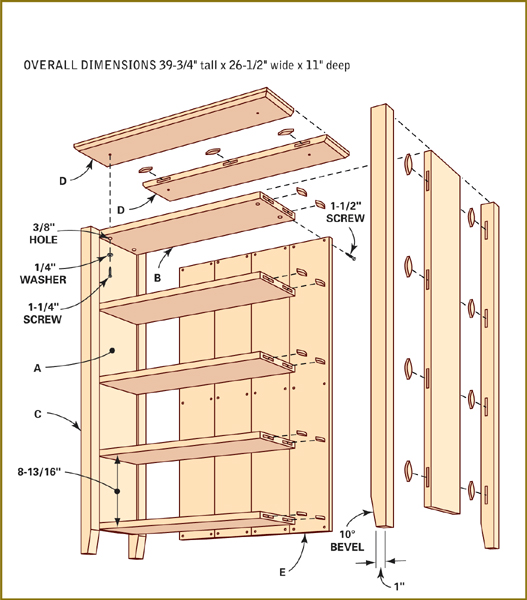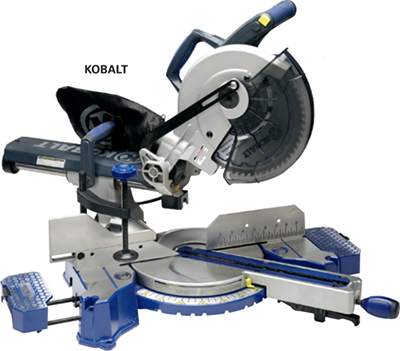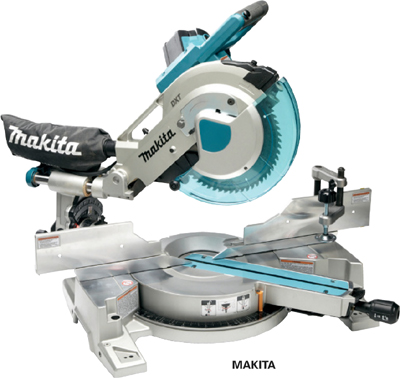


WHAT IT TAKES
Time: 1 day
Skill level: Beginner
Here’s a simple project that gives you a chance to pass some of your woodworking skills on to the next generation. Any kid will love spending the day with you assembling this bookcase. And by the end of the day, your helper will have hands-on experience with several power tools, plus an attractive bookcase to show off.
The bookcase parts are all standard dimensional lumber that you can find at any home center. The total cost of the knotty pine and other supplies we used was about $40. We joined the shelves and legs with biscuits. If you don’t own a biscuit joiner but still want to build this project, you can simply nail or screw the parts together and fill the holes. We used a table saw to cut the 1-1/2-in. square legs from 2x4s and a router with a 45-degree chamfer bit to bevel the edge of the top. If you don’t have a table saw or router, you can just use stock 2x2s for the legs and leave the edge of the top square.
Use the Cutting List as a guide for cutting all the parts. The next step is to mark the shelf positions on the shelf sides. It’s important to keep track of the orientation of the parts. For reference, we placed a piece of masking tape on the top of each side, and on the top side of each shelf. Use a framing square to draw lines indicating the bottom of each shelf (Photo 1).
No need to mark the location of biscuits on the shelves and sides. Instead make marks on the scrap of wood used as a fence. Draw marks to indicate the outside edges of the 1x8 shelves and sides, and mark 1-3/4 in. in from each edge to indicate the center of the biscuits. To use the fence, line up the outside marks with the edges of the part you’re cutting slots in. And then line up the center mark on the biscuit-joining tool with the marks for the center of the biscuits (Photos 3 and 4).
To mark the legs and sides for biscuits, set the legs in position and make pairs of marks that line up with each other on the legs and sides (Photo 2). Put a piece of masking tape on the top of each 2x2 leg, and keep this facing up when you cut the biscuit slots. Photo 7 shows how to bevel the legs.
Biscuit joiners have a flip-down fence that can be used to position the slots, but instead we’re showing a method that allows you to reference the slots from the base of the biscuit joiner. Photos 3 – 6 show the techniques. For a more detailed description of this method, go to familyhandyman.com and type “biscuit joints” into the search box.
Older kids and teens won’t have any trouble mastering the biscuit joiner. With a little coaching, they’ll be cutting slots like a pro. What’s trickiest about cutting the slots is keeping track of the orientation of the parts. Just remember to keep the masking tape facing up, with one exception: The slots on the 1x8 top should be cut with the tape side down.
Here’s where a helper really comes in handy. You have to work fast to spread the glue in the biscuit slots and onto the biscuits (Photo 8), and then assemble the parts before the glue starts to swell the biscuits (Photo 9).
Start by arranging all the parts on your work surface. Use a flux brush to spread the glue in the slots, and onto the biscuits after they are installed. Any small brush will work, though. When you have everything assembled, install clamps to hold the sides tight to the shelves while the glue dries. Check by using a framing square or by measuring diagonally from opposite corners to make sure the bookcase is square. Adjust it if needed. Then tighten the clamps. This is a good time to take a break while you let the glue dry for about an hour.
To minimize potential cupping, we decided to make the top by gluing two pieces of 1x6 together rather than using a solid board. Choose a straight piece of 1x6 with a sharp, clean edge. Cut the pieces long and trim the top to length after you glue the two parts together. For pro tips on gluing boards edge-to-edge, go to familyhandyman.com and enter “edge gluing” in the search box. Cut biscuit slots in the sides of the two 1x6s to help hold them in alignment while installing the clamps. Glue and clamp the two 1x6s. Then let the glue set up about 30 minutes before routing the edge (Photo 10).
The legs are held to the sides of the bookcase with biscuits. When attached, the legs should protrude 1/2 in. past the outside, and overlap the shelves by 1/4 in. Glue in the biscuits, spread a line of glue along the edge of the side, and clamp the legs to the sides (Photo 11). Let the glue set for about 30 minutes.
Drill four 3/8-in. holes at the corners of the bookcase top. The holes are oversized to allow the top to expand and contract. Attach the top with four 1-1/4-in. screws and 1/4-in. washers.
Complete the bookcase by screwing the four 1x6s to the back of the unit (Photo 12). Drill 1/8-in. pilot holes for the screws to avoid splitting.
A little final sanding and the bookcase will be ready for finish. Wipe-on poly or oil finish are both good options.
Figure A

Materials List
ITEM |
QTY. |
1x8 x 8' No. 2 pine boards |
2 |
1x6 x 8' No. 2 pine board |
1 |
1x6 x 10' No. 2 pine board |
1 |
2x4 x 8' pine (rip to 2x2s for legs) |
1 |
No. 20 wood biscuits |
39 |
1-1/2" wood screws |
24 |
1-1/4" drywall or wood screws |
4 |
1/4" flat washers |
4 |
Bottle of wood glue |
1 |
KEY |
QTY. |
SIZE & DESCRIPTION |
A |
2 |
3/4" x 7-1/4" x 36" pine sides |
B |
5 |
3/4" x 7-1/4" x 22-1/2" pine shelves, top and bottom |
C |
4 |
1-1/2" x 1-1/2" x 39" pine legs |
D |
2 |
3/4" x 5-1/2" x 28" pine top (trim to 26-1/2" after joining) |
E |
4 |
3/4" x 5-1/2" x 36" pine back |
Sliding compound miter saw

They’re accurate and portable, with the capacity to cut wide boards and trim. That’s why every carpenter has one of these big bad boys. These 10-in. saws fall into two classes: saws that tilt only to one side like the Kobalt saw, above (mostly $200 or less) and pro tools that tilt to both sides like the Makita, below ($450 and up).
